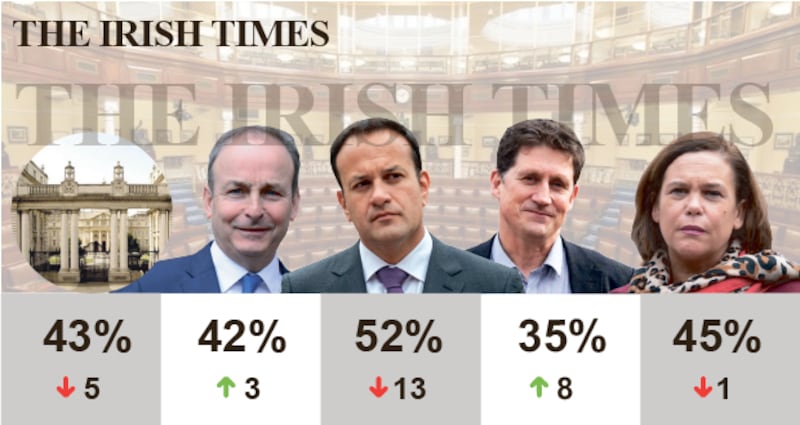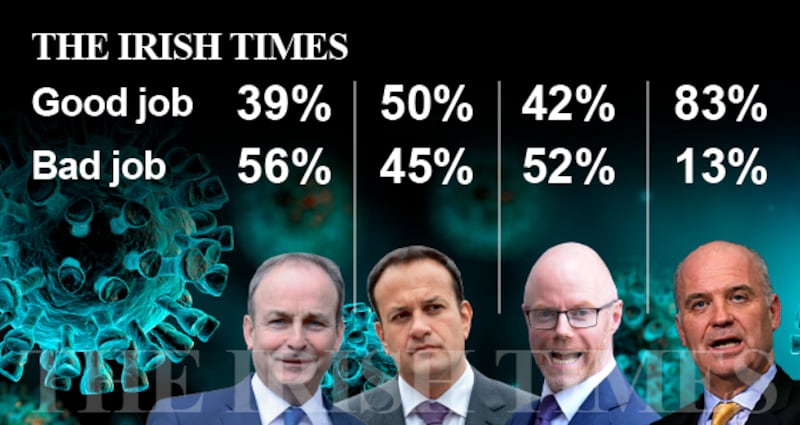The latest Irish Times/Ipsos MRBI poll shows voter satisfaction with the Government continuing to descend from the mountain high rating it reached in the early days of the pandemic. From a peak of 72 per cent, satisfaction has dropped to 43 per cent, as voters turn from looking for a port in the storm to a way out of the harbour.
Fine Gael is confirmed as the most popular party in Ireland, with 30 per cent support, although a drop of five points since our October poll means their lead over Sinn Féin has narrowed.
Sinn Féin attract 28 per cent support, down one point.
Independents and smaller parties have seen their combined vote jump, up eight points to 19 per cent.
For the third successive poll, Fianna Fáil register in the teens, with just 14 per cent support (down three points).
In single digits are Labour (on 3 per cent, down one point) and the Green Party (up two points to 6 per cent).

Fieldwork for this latest poll was conducted by telephone on Monday and Tuesday of this week among a national sample of 1,200 Irish adults aged 18 years and upwards, covering every constituency in the country. The vast majority of interviewing took place before the Taoiseach’s address to the nation on Tuesday evening.
The end is truly in sight according to Micheál Martin and today’s poll suggests Covid is not the only lens through which voters are eyeing the future. The halo effect from taking a national unity approach to dealing with the pandemic, which caused Government and party leader satisfaction ratings to skyrocket, is weakening. These latest findings are less coloured by the pandemic response and are more revealing of the underlying political terrain.
Fine Gael, on 30 per cent, are back in familiar poll territory – between the 2016 and 2020 general elections, the party averaged 29 per cent, so 30 per cent is a solid performance despite a drop of five points since our last poll.
Support for Fine Gael is broadly based regionally (lowest in Rest of Leinster and Munster at 29 per cent and highest in Dublin and Connacht/Ulster at 31 percent) and covers the full age spectrum (only among 25- to 34-year-olds does the Fine Gael number drop below 30 per cent).

Sinn Féin appear to be consolidating their position as the second most popular party in Ireland. A poll rating of 28 per cent is the party’s second highest rating ever.
Among the under 35s, Sinn Féin is utterly dominant, capturing 42 per cent of the vote. Regionally, the party is strongest in Dublin (on 33 per cent) where it outperforms Fine Gael (on 31 per cent).
Fianna Fáil have not benefitted from their role in Government during this turbulent period. Their vote share of 14 per cent represents a drop of three points since October and is well below the 22 per cent share the party won in the 2020 General Election.
The demographic profile of Fianna Fáil voters is not encouraging when viewed in terms of population trends. The party underperforms among the under 35s (7 per cent), Dublin voters (8 per cent) and white-collar households (12 per cent), all of whom are growing population segments and/or will vote in greater numbers in the decades ahead.

The Independents/Others grouping has bounced back, up eight points to 19 per cent, and a sure sign that voters are getting ready to take off the green jersey and replace it with their county colours. The rebound is most noticeable among 25- to 44-year-olds (up 14 points to 23 per cent) and outside Dublin (up six points to 20 per cent).
The Green Party, on 6 per cent in this latest poll, has seen its numbers seesaw over the past 12 months, from a high of 12 per cent in June to a low of 4 per cent in October.
Dublin is typically a stronghold for the Green Party but today’s poll places Munster (on 8 per cent) ahead of Dublin (7 per cent) – not a statistically significant difference but noteworthy nonetheless.
Labour, as the party of choice for just 3 per cent of voters, could be described as languishing in the polls. The party has been trending downwards over the past decade and has yet to find escape velocity from historically low ratings.
As we get closer to exiting the pandemic, Government leaders will come under increasing pressure as the normal business of opposition politics resumes. Already the stratospheric rating achieved by Leo Varadkar during the first phase of lockdown has fallen back to earth.

In this latest poll, the Fine Gael leader scores 52 per cent (down 13 points since October and 23 points since June). Mary Lou McDonald is second in the popularity stakes on 45 per cent (down one point), followed by Micheál Martin on 42 per cent (up three points) and Eamon Ryan, who is up eight points to 35 per cent.
With so much flux over the past 12 months, it is difficult to discern the differences between political waves that come and go and political tides that are likely to endure. That said, there are early signs of a Fine Gael (right) – Sinn Féin (left) axis emerging in Irish politics. This latest Irish Times/Ipsos MRBI poll shows two parties competing head to head, with one party appealing more to the middle classes (Fine Gael) and the other to working-class voters (Sinn Féin).
Right-to-left spectrum politics is the natural order of things for our nearest neighbours, east and west. Polarisation in politics is also an emerging phenomenon and one with which voters in Northern Ireland are very familiar. A drift in this direction for Irish politics may be inexorable.









